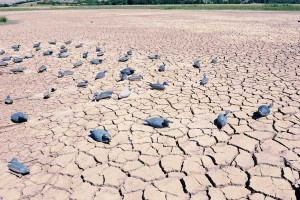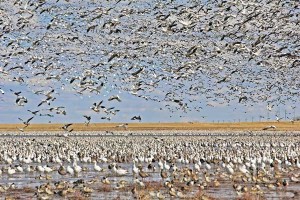January 08, 2014
By David Hart
 When the first waves of ducks arrived at Lower Klamath Basin NWR in September, they were met by an unfamiliar sight: a refuge without water.
When the first waves of ducks arrived at Lower Klamath Basin NWR in September, they were met by an unfamiliar sight: a refuge without water.
For just the second time in 80 years, the marshes were completely dry. January and February were the driest on record in California and the entire state remained in severe drought into September.
California isn't alone. According to the U.S. Drought Monitor, virtually all of the western U.S. remained locked in a moderate to extreme drought deep into September with little hope of relief.
Conditions haven't improved much in parts of Texas, Oklahoma and Kansas since 2011, and numerous western regions remain in what USDM categorizes as "exceptional" drought. That could spell trouble for migrating waterfowl. DU director of conservation planning Mark Petrie says places like the Great Salt Lake are already experiencing the effects of the prolonged dry spell.
Advertisement
"The lack of fresh water means the salinity levels are increasing and that is changing the availability of foods," he says.
Severe drought is also having a dramatic impact on winter habitat in coastal Texas, which has been in an epic drought for five years. Mandatory water restrictions prevented farmers from planting 50,000 acres of rice this year, more than a third of the region's total rice acreage.
According to a DU report, 10,000 acres of rice supports an estimated 120,000 ducks and geese. Coastal Texas is home to 2 million wintering waterfowl.
Advertisement
"If the birds don't have adequate food throughout the winter, they go into the spring migration in poor condition," Petrie said. "We know how important waste rice is to wintering waterfowl, so a significant decline in rice production is going to impact ducks and geese fairly significantly. Some may not make it to their nesting grounds and some others might not be in good enough shape to nest successfully."
Fish First
The same thing is likely to happen in the Pacific Flyway. Petrie says birds will likely bypass Klamath and head straight to the rice-rich Central Valley.
"More pressure on available food means they will deplete their food earlier in the winter," he notes.
The lack of water at Lower Klamath, which supports upwards of 2 million birds during the fall migration, isn't just a result of the region's drought — available water is doled out based on politics. And here, two fish get first dibs.
Lost River and short-nose suckers are endangered species, and as a result, their needs come first. The USFWS is required to maintain water levels in Klamath Lake that are beneficial to the suckers, even at the expense of farmers and wildlife refuges.
"The Fish and Wildlife Service is also required to send a certain amount of water downriver for salmon," says Mark Hennelly, California Waterfowl Association vice president of public affairs and policy. "The needs of those fish come first."
Agriculture interests are second, but it's been a struggle to properly irrigate crops and provide adequate water to cattle in recent months. Ducks and other wildlife that rely on Klamath are last in line.
Killer Outbreaks
The birds that arrive at the bone-dry ponds at Klamath won't stay long, figures Petrie. They'll likely continue on to nearby Tule Lake NWR, which is at full pool because it's at the bottom end of the region's irrigation system. Water that makes it through the maze of canals that feed Klamath Basin's agriculture ends up at Tule.
That's not necessarily a good thing. The refuge was the sight of an avian botulism outbreak in early September that killed an estimated 10,000 ducks and other water birds, a direct result of overcrowding. The disease spread at a rapid pace.
It's not the first time a lack of water has resulted in a major disease outbreak at Klamath. Upwards of 20,000 waterfowl, mostly snow geese, perished from avian cholera in March 2012. Just half the refuge had water, again the result of lower allocations due to drought. The lack of water concentrated birds into small areas, which helped spread the disease.
"I don't see any reason this can't happen again if we continue to deal with low water or no water," says deputy refuge manager Greg Austin.
There is a long-term solution to the Klamath Basin's water issues. The Klamath Basin Restoration Agreement, signed in 2010 by energy company PacifiCorp, along with federal and state officials from Oregon and California, three Native American tribes and a handful of environmental groups, includes the removal of four hydroelectric dams on the Klamath River. It would resolve many of the issues, including refuge water shortages.
Hennelly, however, says the chance of the KBRA passing in its current form is slim.
 "It's a tough sell. The cost of implementing the proposals alone is creating a lot of political opposition," says Hennelly. "There is also some strong local opposition, particularly in the farming community."
"It's a tough sell. The cost of implementing the proposals alone is creating a lot of political opposition," says Hennelly. "There is also some strong local opposition, particularly in the farming community."
In the meantime, the next wave of ducks returning to the Lower Klamath NWR will find some water. Refuge officials were allowed to pump water from Tule Lake NWR back to Lower Klamath in mid-September.
However, Austin says the refuge complex will only have enough water to fill about 3,000 acres, just 10 percent of the total wetlands in a normal year.
"Unless we get some more water, which is unlikely, we are planning on closing the hunting over all water this season. We will still allow field hunts, but there won't be enough water to provide habitat for the birds and for hunting," he says.
Austin says if the KBRA had been approved and fully implemented, the refuge would have gotten enough water to flood about 17,000 acres of marsh, about half the refuge's wetlands.
It's better than nothing, but unless weather patterns shift or the various entities in the region can come to terms, a half-flooded refuge may be the new normal.

